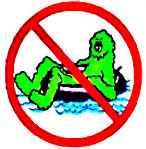During the 1960-70’s, the wholesale use of new (and often underdeveloped) biocides as a weapon against micro-organisms in food production and healthcare was prevalent and it was not until the 1980’s when it was proven that these had caused serious biological and environmental harm that worldwide action was taken to largely ban the use of these toxic chemicals from use, although some remained such as formaldehyde and its derivatives (since removed from medical use as causing asthma and cancer).
Envirolyte has been actively involved in exploring the potential of anolyte as a replacement for chlorine which has been a most effective disinfectant for over a century, eradicating many harmful diseases caused by population growth and poor living conditions. However it has been documented and proved that chlorine when combined with organic material will produce dangerous carcinogenic products or side effects that do not allow widespread use of this chemical on safety or environmental grounds.

Anolyte has since been used as a method of water treatment in commercial and industrial applications, including human waste treatment and oil exploration, ensuring that water courses and the environment have not been overly contaminated by the primary source.
Anolyte, a blend of electrolyzed brine and water, has been developed by Envirolyte to provide a unique electrolyzed water biocidal liquid that provides the cleaning strengths and benefits of chlorine without the dangerous side effects, ensuring no toxic or other side effects to humans or animals.
As anolyte is biodegradable, it is therefore not detrimental to the environment or aquatic life.
Envirolyte has also developed the technology and experience required to enable the product to remain stable and active in storage for up to 18 months, making it an ideal healthcare industry cold sterilization tool with excellent sporicidal, fungicidal and bactericidal powers whilst at the same time.
WHY IS IT BETTER THAN THE OTHER BIOCIDES?
Comparisons of sporicidal cold sterilant options
| Disinfectant | Health & Safety Risks | Risk to equipment being sterilized | Sporicidal Shelf Life | Log 10 6 spore kill time under „clean“ conditions |
| Glutaraldehyde | High | Absorption by plastics | 14-28 days | > 3 hours |
| Peracetic acid | High | Damages copper alloys | 1 day | < 5 mins |
| Chlorine dioxide | Low | Medium | 7 days | < 2 mins |
| Enzyme Surfactants | Low to medium | Low | ||
| Electrolyzed brine | Minimal | Some plastics need protection | Hours | < 2 mins |
| Anolyte | Minimal | Low | > 10 weeks „dirty“ > 12 months „clean“ | < 2 mins |
Anolyte biocidal tests (Log 10 reductions)3
| Sporicidal | Clean1 | Dirty2 |
| Bacillus subtilis var niger | >6.32 | >6.28 |
| Bactericidal to BS EN 1276 | Clean1 | Dirty2 |
| Pseudomonas aeruginosa | >5.00 | >5.00 |
| Escherichia coli | >5.00 | >5.00 |
| Staphylococcus aureus | >5.00 | >5.00 |
| Salmonella typhinurium | >5.00 | >5.00 |
| Klebsiella pneumoniae | >5.00 | >5.00 |
| Fungicidal to BS EN 1275 | Clean1 | Dirty2 |
| Candida albicans | >5.00 | <4.00 |
- 0.03% horse serum;
- Sporicidal tests 1% horse serum; and BS EN 1275/1276 0.3% horse serum;
- Testing carried out at HIRL, Dudley Road, Birmingham, Don Whitley Scientific Ltd, Shipley, West Yorkshire.
Anolyte addresses major public health threats of


M.tuberculosis,MRSA, C.Difficile, E.coli, norovirus, HIV Polio virus, Helicobacter pylori, Salmonella and Legionella

Human and animal influenza, (including H5N1, avian influenza ,swine influenza and COVID-19)
Identified hospital applications of anolyte but not limited to
- Hard Surface treatments
- Hand washing
- Instrument soak and wash
- Decontamination of Endoscopes and Washing equipment
- Decontamination of water storages and pipework
- Secondary disinfectant under EN15883 / HTM 01
- Podiatry – instrument washes and foot soaks
- Radiology – wipe down of hard surfaces and decontamination of ultra sound
- equipment
- Bed and wheelchair washing [compatible with most UK bedwashers
- Laundry pre-treatments
- Fogging clean areas – as part of deep clean or as rapid decontamination
- De-biofilm techniques in endoscopes and dental equipment
Disinfection of a medical facility with anolyte by means of fogging, spraying and washing




